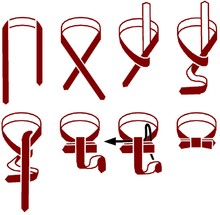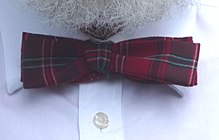Bow tie
The bow tie , also loop (tie loop) or general language fly , in Austria also Mascherl and in Switzerland also tie called (not to be confused with the meaning of this word in Germany , where it synonymous with tie is used) is a fabric band on the shirt collar worn (different from the scarf ) and tied at the front with a bow knot (different from the tie , the long tie ).
History and use
The bow tie has lost a lot of its importance in the course of clothing history, so that the younger tie is much more common today. Originally, the bows worn by noble men were much larger, until they were reduced to the compact format that is still known today in around 1870. Since the beginning of the 2010s , the ribbon has experienced a renaissance in fashion.
Up to the present day it has retained its importance as the only accepted tie for tailcoats (white bow, white tie) and tuxedo (black bow, black tie) on the occasion of festive evening parties. On some occasions, however, a black fly is reserved exclusively for the operating personnel, e.g. B. when the tailcoat is worn as work clothes (butler, waiter).
As part of the official attire of judges and prosecutors, a white bow is permitted as an alternative to a white tie. To dress uniform of the Bundeswehr also a black ribbon can be worn for formal dress , this is mandatory.
In snooker and English billiards sports, it is mandatory to wear a bow tie at professional tournaments.
Ladies also occasionally wear bows with their blouses .
Material and knots
High-quality bows as well as high-quality ties are made from brightly printed or woven pure silk , while the white tailcoat bows are always made from piqué cotton . Other possible materials are polyester , also as microfibre , viscose , wool , linen or linen blend or cord . Some designer bow ties are made entirely or partially of materials that are not textiles such as leather, cork, wood, metal, cardboard, felt, etc.
A large part of the bow ties sold are pre-tied models with sewn-in knots, which are available with an adjustable elastic band, fabric band or a hook to hang on the top button.
The classic form is the self-tied bow tie. At high festivities, wearing a pre-tied bow is a faux pas. The bow is tied as a square knot on both sides of the slip , like an ordinary shoe bow with double loops. Some loops that you can tie yourself also have hooks and eyes. While there are a variety of knots for ties, there is only one knot for bows, apart from exotic ones. In contrast to ties, the knot in a bow cannot be moved; the width of a bow cannot be changed after it has been tied. As a variation, the ribbon can be rotated when tying, so that a diagonal crease is formed in the middle of the vertical part of the knot, from which a tied bow tie can be recognized. Tied flies usually have small irregularities and are often fuller in the middle than pre-tied flies.
to form
Three different forms are common for bow ties: the butterfly, the batwing and the diamond point. The Butterfly is the classic among the flies. It is the most widespread and most popular form worldwide. The batwing is a bit narrower. The Diamond Point Bow Tie is characterized by the pointed ends that are supposed to be reminiscent of a diamond.
Pre-tied bow tie made of silk, paisley pattern
literature
- Davide Mosconi, Riccardo Villarosa: Bow ties and ties. The binding art of the fine knot. 188 intricate possibilities. DuMont, Cologne 1985, ISBN 3-7701-1755-7 .
Web links
Individual evidence
- ↑ www.mensvita.de
- ↑ adambows.com , accessed January 18, 2017











